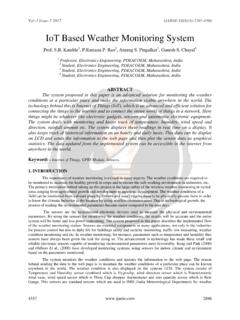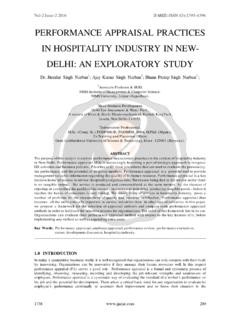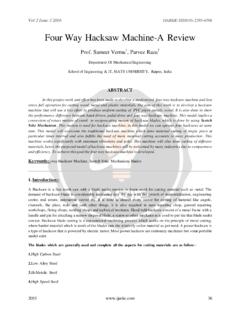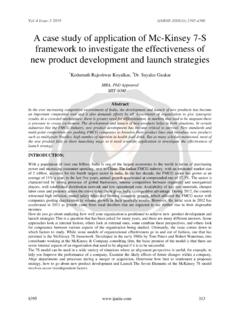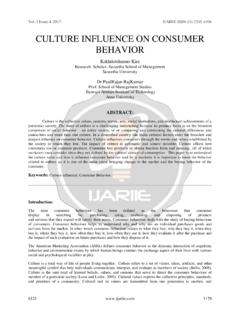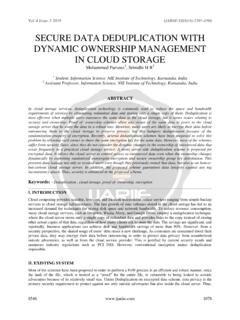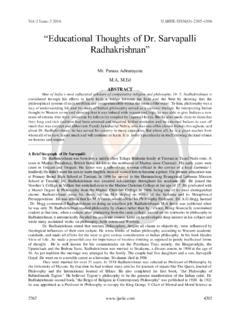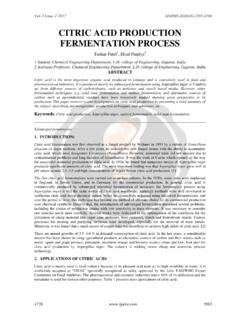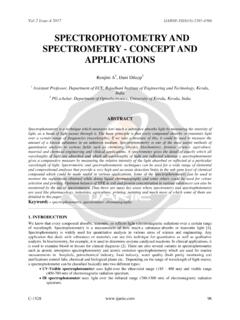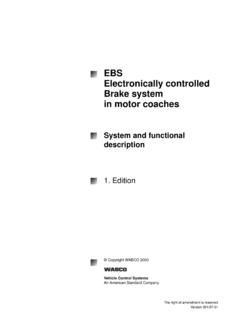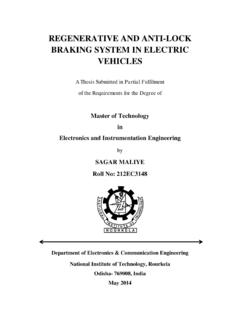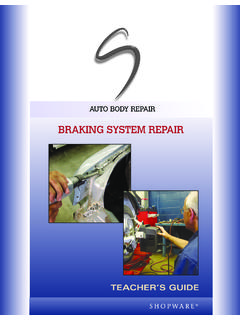Transcription of Vacuum braking system - IJARIIE
1 Vol-3 Issue-2 2017 IJARIIE -ISSN(O)-2395-4396. Vacuum braking system Ravi , Deepak Kumar Bharti2, Pravin Pune3 ,Nikhil Kumbharde 4,Prof. Londhe 1. Student, Mechanical Department, SND COLLAGE OF ENGINEERING & RESEARCH CENTER. YEOLA, NASHIK-423401, Maharashtra, India 2. Student, Mechanical Department, SND COLLAGE OF ENGINEERING & RESEARCH CENTER. YEOLA, NASHIK-423401, Maharashtra, India 3. Student, Mechanical Department, SND COLLAGE OF ENGINEERING & RESEARCH CENTER. YEOLA, NASHIK-423401, Maharashtra, India 4. Student, Mechanical Department, SND COLLAGE OF ENGINEERING & RESEARCH CENTER.
2 YEOLA, NASHIK-423401, Maharashtra, India ABSTRACT. In railway locomotives, Vacuum brakes are first used instead of the air brakes. In, the brake pipe, Vacuum pump is used for creating Vacuum . The integral construction of the brake cylinder uses this Vacuum reservoir for the application of brakes. Nowadays many of the light vehicles are fitted with Vacuum -assisted hydraulic braking system in which Vacuum is created from the engine which reduces the driver effort on foot pedal. The Vacuum braking system was developed from above said reasons and the same analysis for implementation in both heavy and light vehicles.
3 In this system , Vacuum is created from engine and used for the making of application of brakes. The system operation is similar to air braking system . In vaccum brake system the Vacuum is used rather than of compressed air which is used in air brake system . The design and modified system also includes the Vacuum brake system , the loss of Vacuum will cause the brake to be applied due to spring force. Keywords: Air braking system , Fail safe condition, Heavy vehicle, Hydraulic brake, Light vehicle, Vacuum braking system . introduction . A moving train contains kinetic energy, which needs to be removed from the train for stopping the train.
4 The best way of doing this is to convert the energy into heat. The conversion of kinetic energy into heat is usually done by adding a contact material in between the rotating wheels or to discs which is attached to the axles. The material which is added creates friction and converts the kinetic energy into heat. The speed is slow down and the train stops. For the braking the material used is pad or blocks. In the world's many trains are equipped with braking systems which use compressed air as the force for pushing the blocks on wheels. Such type of braking system known as "air brakes" or "pneumatic brakes".
5 In these braking system the compressed air is transmitted along the train through a device known as a brake pipe. Different level of air pressure in the pipe causes a change in the magnitude of the brake on each vehicle. This can apply the brake, release it or hold it "on" after a partial application. This system is in limited use all over the world. There is alternative braking system to the air brake, known as the Vacuum brake[VB], which was introduced around the early 1870s, the same time as the air brake. Similar to the air brake, the Vacuum brake system is controlled or operated through a brake pipe.
6 But the brake pipe connecting a brake valve in the driver's cab with braking equipment on every vehicle. The operation of the brake equipment on each vehicle depends on the condition of a Vacuum created in the pipe by an ejector or exhauster. The ejector, using steam on a steam locomotive, or an exhauster, using electric power on other types of train, removes atmospheric pressure from the brake pipe to create the Vacuum . When a full Vacuum in the brake pipe, the brake is released & when no Vacuum , normal atmospheric pressure in the brake pipe, that time the brake is fully applied.
7 4680 3645. Vol-3 Issue-2 2017 IJARIIE -ISSN(O)-2395-4396. The atmospheric pressure means 1 bar or about lbs. per square inch. When reducing the atmospheric pressure to 0 lbs. per square inch, it creates a near perfect Vacuum which is measured as 30 inches of mercury, written as 30. Hg. Each 2 inches of Vacuum therefore represents square about 1 lb. per inch of atmospheric pressure. In the UK, Vacuum brakes operated with the brake pipe at 21 Hg, except on the Great Western Railway which operated at 25 Hg. In the brake pipe the Vacuum is created and maintained by a motor-driven exhauster.
8 The exhauster has two types of speeds, high speed and low speed. The high speed is switched in to create a Vacuum and therefore release the brakes. The slow speed is used to keep the Vacuum at the required level to maintain brake release. It maintains the Vacuum for preventing small leaks in the brake pipe. The Vacuum in the brake pipe is prevented from exceeding its nominated level (normally 21 Hg) by a relief valve, which opens at the setting and lets air into the brake pipe to prevent further increase. The momentum of a moving body increases with weight and speed of the body as these factors increase improvements in the brake become so important.
9 The adhesion of the wheels and speed of the train are the main factors that determines the total retarding power. The maximum retarding force applied by the brake blocks at wheels depends upon the coefficient of friction between the wheels and the rail and the component of the weight of the wagon on the wheels. Mathematically the retarding force F can be expressed as F = * W. Where = the coefficient of friction W = component of weight of wagon on the wheels If the coefficient of friction becomes equal to unity then the retarding force will be equal to the weight of the wagon.
10 Also the deceleration equals the acceleration due to gravity. Then the braking efficiency is 100%. This is the theoretical limit for braking efficiency. Highly efficient brakes giving a large deceleration might injure the passengers due to sudden stopping of the train .More over this will cause the brake shoes to wear rapidly and their is always the risk of derailment. The braking efficiencies usually vary from 50% to 80%, which enables the train to stop safely with in a reasonable distance. The equations used for the calculations of acceleration can also be used for calculating the braking distance except to the accelerating force becomes the braking force F b The brake force Fb = p* *.
